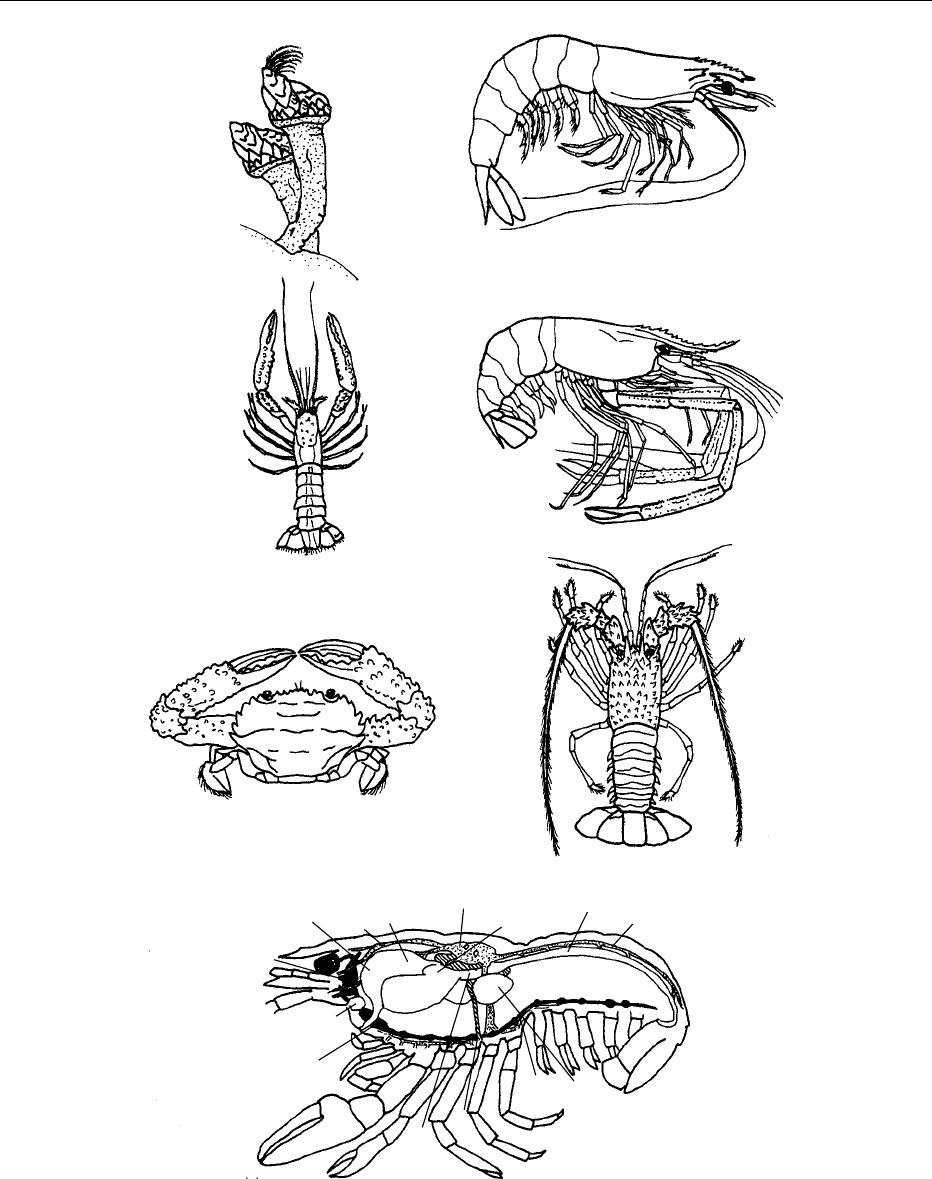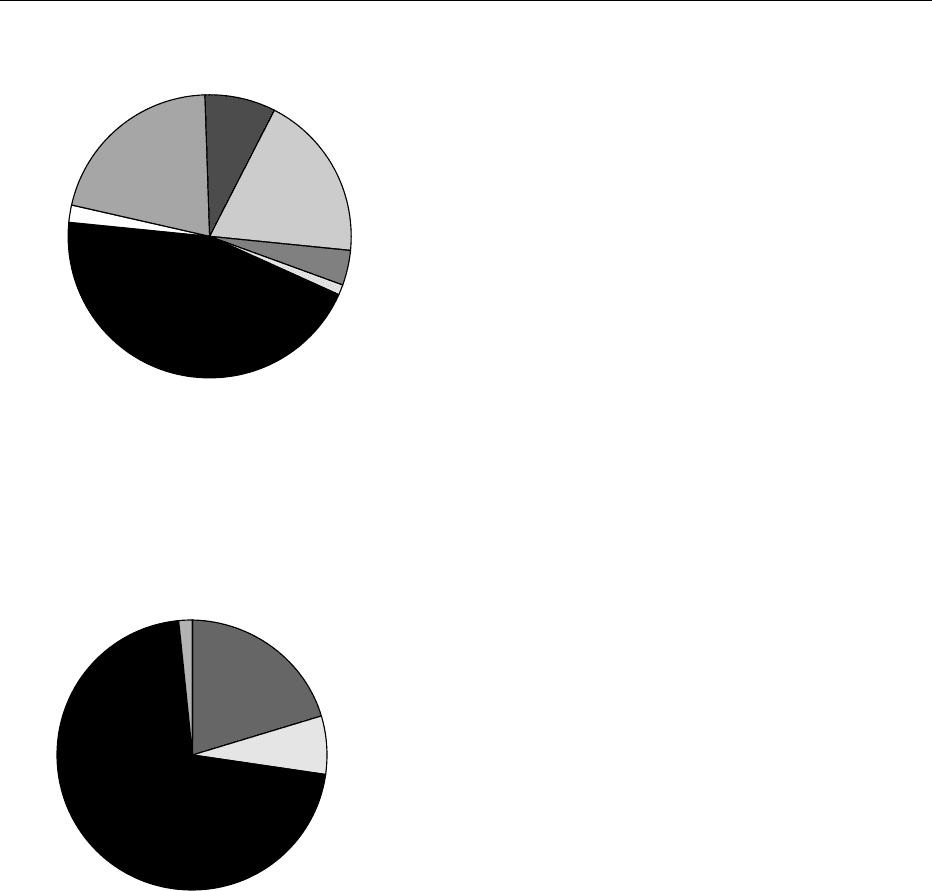Caballero B. (ed.) Encyclopaedia of Food Science, Food Technology and Nutrition. Ten-Volume Set
Подождите немного. Документ загружается.


swimming in malacostracans. In this group the ter-
minal somite bearing the anus forms a flattened
telson, and the last pair of abdominal segments are
modified to form uropods; together with the telson;
these form a tail fan used in swimming.
0014 The gut is divided into a chitin-lined fore- and
hindgut and a midgut lined with endoderm. The fore-
gut esophagus leads to a stomach which is often
subdivided into cardiac and pyloric regions in mala-
costracans. The midgut forms an intestine of variable
length and bears the digestive cecae or hepato-
pancreas, emptying into the pyloric chamber of the
stomach. The hindgut is usually short, absorptive in
function, and leads to the anus. In crabs and lobsters,
mechanical breakdown of food in the gastric cham-
bers of the stomach is performed by heavily sclero-
tized teeth which form a grinding gastric mill; in
shrimps this structure may be absent and breakdown
is solely by enzymes secreted from the hepato-
pancreas. The products of digestion are absorbed
by cells in the fine tubules of the hepatopancreas,
or cells lining the midgut trunk, where further
intracellular digestion occurs. In some groups, ex-
pelled fecal material is sheathed in a peritrophic mem-
brane.
0015 The circulatory system is comprised of a dorsal
muscular heart with ostia or pores to draw in blood
from the pericardial cavity. In advanced malacostra-
cans the heart has a series of blood vessels insuring
that blood flows to body organs and to the gills
(Figure 1). Return to the heart is via pools or the
hemocoel, although active crustaceans may have a
primitive venous system to return the blood to the
pericardial cavity. Gaseous exchange in large,
advanced crustaceans is via gills, which arise as
branches from the base of the thoracic limbs. The
gills are modified in various ways to provide a large
surface area of thin, permeable cuticle, and in deca-
pods are protected under the carapace in branchial
chambers through which ventilating currents of water
are drawn.
0016Excretion is in the form of ammonia, which is
released across gill surfaces and via nephridia in max-
illary or, in most malacostracans, antennal glands
(Figure 1). These glands are also active in osmoregu-
lation, as are the gill surfaces. The crustacean cuticle,
unlike the waxy insect cuticle, is largely permeable,
and imposes severe constraints upon ionic regulation;
hence few crustaceans are found away from water.
0017The crustacean brain is composed of three fused
ganglia – two anterior dorsal supraesophageal
ganglia and a third which forms a pair of circumen-
teric connectives extending round the esophagus to a
subesophageal ganglion linked to the ventral nerve
cord. This cord bears paired segmental body ganglia.
The optic and antennulary nerves run to the supra-
esophageal ganglia, and the subesophageal ganglia
often become a large, fused mass serving the nerves
to the mandibles, maxillules, maxillae, and maxilli-
peds. In crabs all the thoracic ganglia fuse to form a
large ventral nerve plate. Sensory systems are well
developed, despite the exoskeleton, and take the
form of innervated setae responding to touch or cur-
rents, whilst others, such as esthetascs, detect chem-
icals or gradients in attractants emanating from food.
0018Crustaceans are well adapted to detect light, and
photoreceptors range from the simple larval naupliar
eye, responding to light direction and intensity, to the
tbl0001 Table 1 Pennant (1771) classification of phylum, subphylum or superclass Crustacea utilized directly for human nutrition
Class Maxillopoda
Subclass Cirripedia
Order Thoracica Stalked barnacles, e.g., Pollicipes
Subclass Copepoda
Order Calanoida Copepods, e.g., Calanus plumchrus
Class Malacostraca
Subclass Hoplocarida
Order Stomatopoda Mantis shrimp (Squilla mantis)
Subclass Eumalacostraca
Superorder Peracarida
Order Mysidacea Possum shrimp (Neomysis intermedia)
Superorder Eucarida
Order Euphausiacea Krill, e.g., Euphausia superba
Order Decapoda
Suborder Dendrobranchiata Penaeid and sergestid shrimps, e.g., Penaeus, Sergestes
Suborder Pleocyemata
Infraorder Caridea Caridean and procaridean shrimps, e.g., Macrobrachium, Palaemon
Infraorder Astacidea Crayfish and chelate lobsters, e.g., Astacus, Homarus, Nephrops
Infraorder Palinura Palinurid, spiny, and slipper lobsters, e.g., Panulirus, Palinurus,Thenus, Scyllarides
Infraorder Anomura Galatheid crabs, king crabs, e.g., Paralithodes, Pleuroncodes
Infraorder Brachyura Crabs, e.g., Cancer, Scylla, Callinectes, Maia
SHELLFISH/Characteristics of Crustacea 5207

(a) (b)
(c)
(d)
(e)
(f)
(g)
sog
fg
aa
cs
h
ps
hg
pa
hp
vc
o
mg
sg
ag
fig0001 Figure 1 (a) Stalked barnacle (Pollicipes sp.); (b) Penaeus shrimp; (c) (Macrobracium Norway lobster (Nephrops sp.); (d) caridean
shrimp (Macrobracium sp.); (e) swimming crab (Charybdis sp.); (f) spiny lobster (Panuliris sp.); (g) fresh-water crayfish (Astacus sp.). sog,
supraesophageal ganglia; fg, foregut; aa, anterior aorta; cs, cardiac stomach; h, heart; ps, pyloric stomach; hg, hindgut; pa, posterior
aorta; hp, hepatopancreas; vc, ventral nerve cord; o, oviduct; mg, midgut; sg, subesophageal ganglion; ag, antennal gland. Repro-
duced from Shellfish, Encyclopaedia of Food Science, Food Technology and Nutrition, Macrae R, Robinson RK and Sadler MJ (eds), 1993,
Academic Press.
5208 SHELLFISH/Characteristics of Crustacea

stalked, multifaceted compound eye found in deca-
pods. This is capable of discerning shapes, patterns,
and movement and at least some have color vision.
Molting, chromatophore activity, tidal and daily
locomotor rhythms, and aspects of reproduction are
under hormonal and neurosecretory control, but an
understanding of the mechanisms of this control is
still at an early stage.
tbl0002 Table 2 Composition of commercial crustaceans (all figures are per 100 g of raw material, except Homarus, which is boiled)
Energy
(kcal)
Carbohydrate
(g)
Protein
(g)
To t a l f a t
(g)
Fattyacids Cholesterol
(mg)
Saturated
(g)
Mono-
unsaturated (g)
Poly-
unsaturated (g)
n-3 (g)
Crab (mixed) 74–95 0–2.2 15–18 0.8–1.9 0.16–0.17 0.22 0.4–0.5 0.38–0.44 60–78
Penaeid shrimp 87–100 0–2.7 17–22 0.4–0.8 0.11–0.2 0.05–0.15 0.09–0.49 0.07–0.34 96
Panulirid lobster 100 1.7 19.2 1.2 0.14 0.14 0.59 0.27 106
Homarid lobster 93 5.4 20.5 0.6 0.08 0.13 0.07 0.06 72
Data modified from various sources.
tbl0003 Table 3 Habitats and global distribution of crustaceans utilized for human nutrition
Group Habitat Distribution (commercial fisheries)
Marine
Copepods Pelagic Norway, Canada, Japan
Cirripedes Rocky, coastal Portugal
Mysids Pelagic, coastal, estuarine Japan, South-east Asia, China, Korea
Euphausiids Pelagic, offshore Antarctica, Canada, Norway, Mediterranean
Sergestids Pelagic, coastal, estuarine China, South-east Asia, Japan, East Africa, India,
Brazil, Surinam, Philippines
Penaeid shrimp (60 species) Benthic, soft-substrate, nutrient-rich,
estuarine, coastal
Worldwide between 40
N and 40
S
Plesiopenaeus Benthic, soft-substrate, deep-water Atlantic, Australia, South Africa
Pleoticus Soft-substrate, deep-water South-west Atlantic
Caridean shrimp
Crangon Benthic, soft-substrate, coastal Europe, former Soviet Union, Algeria
Pandalus Benthic, coastal to 1500 m North Pacific, Atlantic
Palaemon Benthic, rocky, coastal Europe, Algeria
Stomatopoda Benthic, rocky, coastal Tropical to Mediterranean
Lobsters
Homarus Benthic, rocky-soft, coastal to 700 m North Atlantic, Mediterranean
Nephrops Benthic, soft substrate, 15–800 m North-west Atlantic, Mediterranean
Panulirids Benthic, rocky, coastal, 700 m 30
N–50
S worldwide
Syllaridae Benthic, soft-rocky, coastal Mediterranean, Japan, Indian Ocean
Anomurans
Galatheids Benthic, rocky, coastal Mediterranean, Japan, western USA
Lithodes Benthic, rocky-soft, coastal South-west Atlantic
Paralithodes Benthic, rocky-soft, coastal North-west Pacific
Crabs
Chionecetes Benthic, rocky, coastal North-west Atlantic, north-west Pacific,
east central Atlantic
Maia Benthic, rocky, seaweeds, coastal Mediterranean
Cancer Benthic, rocky-soft, coastal Africa, north-east and central Atlantic, Mediterranean,
north-east and -west Pacific, east central Pacific
Portunids Benthic, rocky-soft, coastal North-east Atlantic, Asia, west Pacific
Callinectes Benthic, rocky-soft, coastal, shelf edge West and north-west Atlantic
Scylla serratus Benthic, mangal, coastal Asia, India, west central Pacific
Geryon Benthic, soft, 300–1500 m North-west Atlantic
Fresh water
Caridean shrimp
Macrobrachium Estuaries, rivers, benthic, soft-substrate Tropical, introduced worldwide
Palaemonids Estuaries, rivers, lakes, soft, benthic Tropical
Astacidea
Crayfish Rivers, lakes, streams, rocky-soft, vegetated Temperate to tropical, worldwide
SHELLFISH/Characteristics of Crustacea 5209

0019 Sexes are separate in most crustaceans, but even
some advanced malacostracans such as Pandalus
may be protandrous hermaphrodites (maturing first
as males, then later changing sex). Gonads are
paired structures which are found in various regions
of the trunk and empty via genital pores, usually
on a trunk sternite. In male decapods an anterior
pair of pleopods is modified for sperm transfer.
Sperm is deposited directly into the oviduct or into
a seminal receptacle, where it may be stored for
some time. Crustaceans may brood fertilized eggs,
usually in an external pouch (mysids) or attached
to pleopods (most decapods), but exceptionally
(penaeids) may release their eggs freely into the
sea.
0020 Typically crustacean eggs hatch into planktonic
larval forms, although these are suppressed, for
example, in the Mysidacea, Amphipoda, Isopoda
and fresh-water Astacidea, where direct development
occurs. The most primitive larva is the nauplius, with
a single median simple eye and three pairs of bira-
mous limbs; this is followed by the zoea and mega-
lopa, gaining additional limbs and segments at each
molt. A wide variation in numbers of larval stages and
duration is seen; penaeids have 12 stages extending
over 13 days, homarid lobsters four stages over 15
days, whilst the planktonic life of palinurids may
extend up to 12 months.
0021 Table 2 gives the composition of crustaceans com-
monly consumed by humans and reveals that all
are low in saturated fats, high in polyunsaturates,
particularly the highly unsaturated n-3 series, and
contain medium levels of cholesterol. (See Carbohy-
drates: Requirements and Dietary Importance;
Energy: Measurement of Food Energy; Fats: Require-
ments; Protein: Requirements.)
0022 Several crustacean groups (copepods, branchiur-
ans, cirripedes, and isopods) have given rise to para-
sites which may cause serious infestations in edible
fish and shellfish.
Habitats and Distribution
0023 Apart from the pelagic zooplanktonic copepods,
mysids, euphausiids, and sergestids, which are mainly
fished commercially in colder productive waters
(Table 3), most other crustaceans only occur in com-
mercial densities in shallow coastal seas. The fast-
growing, high-value penaeid shrimp are restricted to
warmer waters, as many have life cycles associated
with estuarine mangals, and many burrow in sands
and muds. In contrast, the slower-growing caridean
shrimps are centered in the northern boreal region,
where the shallow-sea pandalids make up the bulk of
the fisheries.
0024The slow-growing homarid lobsters also have a
cold-to-warm temperate distribution and are re-
placed in warmer seas by the panulirid and scyllarid
lobsters. The most productive crab fisheries used to
be those for king crabs (Paralithodes) and snow crabs
(Chionecetes) from the North Pacific and Alaska, but
blue crabs (Callinectes) from the western Atlantic
have recently produced the highest landings. Al-
though most lobsters and crabs show a preference
for rocky habitats, both Cancer and Homarus will
construct burrows in soft substrates.
0025Many crustacean groups have invaded fresh-water
habitats, but only caridean shrimp, notably Macro-
brachium and crayfish, attain commercial fishery
sizes. The former are restricted to tropical waters,
whilst the latter occur worldwide. European crayfish
populations declined as a result of disease, but recent
introduction of expatriate species has led to these
becoming pests, particularly in Africa and southern
Europe.
See also: Carbohydrates: Requirements and Dietary
Importance; Energy: Measurement of Food Energy; Fats:
Requirements; Protein: Requirements
Further Reading
Bowman TE and Abele LG (1982) Classification of the
recent crustacea. In: Bliss DE (ed. in chief) The Biology
of Crustacea, vol. 1, pp. 1–25. New York: Academic
Press.
Brusca RC and Brusca GJ (1990) Invertebrates, pp. 1–922.
Sunderland, Massachusetts: Sinaver Associates.
Provenzano AJ (1985) Economic aspects: fisheries and cul-
ture. In: Bliss DE (ed. in chief) The Biology of Crustacea,
vol. 10, pp. 1–331. New York: Academic Press.
Commercially Important
Crustacea
B D Paterson, Bribie Island Aquaculture Research
Centre, Bribie Island, Australia
Copyright 2003, Elsevier Science Ltd. All Rights Reserved.
Background
0001Visit a fish market, supermarket, or restaurant any-
where in the world, and a variety of crustaceans are
likely to be presented for sale. The particular species
found will depend greatly upon the country and
the region concerned. However, as crustaceans and
other kinds of seafood move further afield with the
5210 SHELLFISH/Commercially Important Crustacea

increasing international trade in food products, this
means both an increasing variety in the product dis-
played in the major markets of Asia, USA, and
Europe, and more intense competition within broad
product categories. As a consequence, the names of
imported product can be a hot ‘branding’ issue
amongst local producers. But rather than perpetuat-
ing arbitrary distinctions, for example about what
constitutes a ‘true’ lobster, in order to objectively
come to grips with the varieties of crustaceans
produced in significant quantities throughout the
world, it is easier to consider the three broad product
groups; shrimp, lobsters, and crabs. These commod-
ity divisions nevertheless mirror broad taxonomic
differences, largely because the morphology of
crustaceans has a large impact on their processing
and marketability.
0002 Most of the commercially important crustaceans
are decapods, the group containing the largest and
most familiar crustaceans (Table 1). The sheer diver-
sity and global distribution of fished and cultured
crustacea seemingly count against any attempt at a
detailed statistical compilation. But it is possible,
within the limits of the data available, to find major
patterns in the production figures and identify out-
standing species. Of course, species that do not rate
highly in terms of global production can still be com-
mercially important. They may be high in value and
on display, such as crustaceans marketed alive, or
they may be less valuable but still contribute locally
to nutrition, employment, and prosperity. Commer-
cial exploitation itself is enough to warrant local
regulation and management of stocks or farming
operations, though, now, the viability of ‘local’
industries and the quality of their products have
reached new horizons of concern, now that quality
and sustainability are the concern of world consumers
and trade regulators.
0003The total global production of crustaceans from
fisheries and aquaculture was 7.8 million tonnes in
1999, and crustaceans represented about 20.1% of
global aquaculture production in that year. Shrimps
and shrimp-like crustaceans account for about half
the global crustacean trade, largely due to the large
output of shrimp fisheries and an increasing compon-
ent of farmed tropical marine shrimp. About 81%
(6.3 million tonnes) of harvested crustaceans came
from capture fisheries, so the taxonomic/market
breakdown of this group (Figure 1) still has a signifi-
cant effect on global totals. Marine shrimp currently
dominate the crustacean farming sector (Figure 2),
with much of the remaining farm production based
in freshwater.
0004Beyond the level of the total contribution by vari-
ous taxa, it is not always possible to categorically
identify the most important species by isolating
these data from the production figures. Sometimes,
the compiled global statistics for particular groups
include large percentages of production that cannot
be assigned to anything but the broadest taxonomic
categories. Nevertheless, the species that emerge from
the data contain no surprises, even where relatively
large proportions of production remain unspecified.
0005While the better known crustaceans originate from
the world’s oceans, it would be wrong to discount
altogether the 10% of global production of crust-
aceans that originates from freshwater sources.
While these of course are also shrimp, crabs, or
indeed ‘lobsters’, they deserve separate treatment,
because they do not necessarily compete in the same
market segments as their marine relatives.
Marine Shrimp
0006The suborder Natantia (shrimps and prawns) are
decapod crustaceans adapted for swimming, with
a light cuticle and a well-developed abdomen with a
tbl0001 Table 1 Taxonomic relationships amongst commercially
important crustacea
Crustacea (Class)
Decapoda (Order)
Natantia (Suborder)
Caridea (Infraorder)
. Crangonidae (Family) Crangon crangon
. Palaemonidae (Family) Macrobrachium rosenbergii
. Pandalidae (Family), e.g., Pandalus borealis
Penaeoidea (Infraorder)
. Penaeidae (Family), e.g., Penaeus spp.
. Sergestidae (Family), paste shrimp, Acetes japonicus
Reptantia (Suborder)
Anomura (Infraorder)
. Galatheidae (Family), Squat lobsters, Pleuroncodes
monodon
. Lithodidae (Family), Stone crabs, Paralithodes
camtschaticus
Astacura (Infraorder)
. Cambaridae (Family), Freshwater crayfish, e.g.,
Procambarus clarkii
. Nephropidae (Family), Lobsters, e.g., Homarus
americanus, Nephrops norvegicus
. Parastacidae (Family) Freshwater crayfish, e.g.,
Cherax quadricarinatus
Brachyura (Infraorder)
. Cancridae (Family), Edible crabs, e.g., Cancer spp.
. Majidae (Family), Spider crabs, Chionoecetes spp.
. Portunidae (Family), Swimming crabs Portunus
trituberculatus, Callinectes sapidus
Palinura (Infraorder)
. Palinuridae (Family), Spiny lobsters, e.g., Panulirus
argus
Euphausiacea (Order)
. Euphausiidae (Family), Krill, Euphausia superba
SHELLFISH/Commercially Important Crustacea 5211

full complement of swimmerets. The abdomen is also
used for the powerful tail-flicks that the shrimp uses
to flee danger, so it is ironic that it is this very adapta-
tion that makes shrimps so commercially attractive.
0007 Production of shrimp in 1999 was about 4 million
tonnes. There is sufficient detail in the global statistics
to be sure of the general spread of taxonomic groups,
as only about 13% of recorded production is un-
assigned. The diversity in this group is such that a
number of major taxonomic groups of shrimp and
shrimp-like organisms are involved. Three quarters of
the total shrimp production is represented by shrimps
of the Infraorder Penaeoidea, most of that accounted
for by several species of the diverse and widespread
Family Penaeidae (2.4 million tonnes). The Sergesti-
dae, a group common in deeper water, make up a
major slice of the remaining penaeoids harvested,
and most of that is the akiami paste shrimp Acetes
japonicus, a species used for manufacture of paste,
salted, and fermented products. While another major
superfamily, the Caridea accounts for only 10% of
the global production of shrimp (or 430 000 tonnes),
the bulk of that (91%) is represented by a single
North Atlantic species of pandalid shrimp, the North-
ern shrimp, Pandalus borealis. The remaining data
for the caridean shrimp are mostly taken up by land-
ings of common shrimp Crangon crangon (around
37 000 tonnes).
0008The diversity of the shrimp group is such that it is
not possible to discuss all in detail. If we arbitrarily
consider species to which landings represent individu-
ally more than 10% of total shrimp landings, four
species stand out. The paste shrimp and the Northern
shrimp (Acetes japonicus and Pandalus borealis) have
already been mentioned, but to this group should be
added the giant tiger shrimp, Penaeus monodon (on
the basis of farmed production!), and the southern
rough shrimp, Trachypenaeus curvirostris. But this
summary perhaps unfairly overlooks the diversity of
other species of the Penaeidae such as the banana
shrimp Farfantepenaeus merguiensis, P. chinensis,
and P. aztecus.
0009By 1999, aquaculture accounted for over a third of
of global shrimp production (1.1 million tonnes). As a
market segment, farmed shrimp has been floating
around 20–25% of global shrimp landings since
the mid-1990s, the upward trend being checked or
reversed by outbreaks of shrimp viral diseases at
various times around the world, with consequences
for supply and pricing felt throughout the market.
The farmed shrimp are also penaeids and about
half of the total is represented by farmed production
of giant tiger shrimp Penaeus monodon. The three
most notable farmed shrimp in the FAO statistics
(in order of decreasing quantities) are the giant
tiger shrimp (Penaeus mondon), the Pacific white
shrimp Litopenaeus vannamei, and the Chinese
white shrimp Penaeus chinensis. L. vannamei is
farmed in the Americas, while the other two species
are produced in South-east Asia. These species also
figure highly in wild production statistics, though the
farmed production for these species now exceeds
the corresponding fisheries production.
0010Shrimp, which probably owes its dominance to
sheer biological abundance as well as simple peeling
and high meat recovery (50–60% of fresh weight),
lends itself to a diversity of processed fresh/frozen and
1%
45%
2%
21%
8%
19%
4%
Freshwater
crustaceans
(various)
Marine crabs
(Brachyura)
Marine
lobsters
Marine
crab-like
lobsters
(Anomura)
Marine shrimp
(Natantia)
Krill
Unspecified
fig0001 Figure 1 Global fisheries production of major product/taxo-
nomic groups of crustaceans in 1999. From Anon (1999) FA O
Fishery Statistics: Capture Production; Aquaculture Production; Com-
modities, vol. 88(1–3). Rome: FAO.
71%
2%
20%
7%
0%
Unspecified
Freshwater
crustaceans
(various)
Marine crabs
(Brachyura)
Marine
lobsters
Marine shrimp
(Natantia)
fig0002 Figure 2 Global farmed production of major product/taxonomic
groups of crustaceans in 1999. From Anon (1999) FA O Fi s h e r y
Statistics: Capture Production; Aquaculture Production; Commodities,
vol. 88(1–3). Rome: FAO.
5212 SHELLFISH/Commercially Important Crustacea

packaged, value-added forms. Live marketing of the
kuruma shrimp (Marsupenaeus japonicus) involves
relatively small quantities but is noteworthy for the
high prices achieved. Chilled, raw shrimp have a
limited shelf-life, so much of the product is processed
at sea or on farm in various ways to allow for
marketing. This might involve simply packaging and
freezing the raw or cooked shrimp in a manner suit-
able for sea-freight, but more sophisticated process-
ing is increasingly being practiced (Figure 3).
0011 One concern with minimal processing is ‘black
spot’, a form of enzymatic spoilage common to
commercial crustacea. This melanosis is mediated
by polyphenoloxidases in the shell or hemolymph
(blood). (See Browning: Enzymatic – Biochemical
Aspects.) ‘Black spot’ can be avoided to some extent
by removing the shell or by thorough cooking (to
deactivate the enzymes), or treating the product to
inhibit the formation of melanin. A widespread
‘black-spot’ treatment is to dip the raw or cooked
shrimp in a solution of sodium metabisulfite or re-
lated chemicals (which scavenge oxygen, a require-
ment for melanosis). However, concerns over
introducing undesirable sulfite residues into the prod-
uct has recently led to adoption of other methods.
One of these involves an enzyme inhibitor (4-hexyl-
resorcinol), which interrupts the enzyme cascade
leading to melanin.
0012 Given the diversity of species, it would be wrong to
say that there is one homogeneous global market for
these ‘commodity’ shrimp, though few sectors seem
immune from the ups and downs of supply and
demand. The meat of different species varies in ap-
pearance, flavor, and texture, and this still explains
some market segmentation in countries or regions
where historically consumers ate particular types or
shrimp or prawns. Marine penaeid shrimp have al-
ready made inroads into the European market, where
Pandalus borealis once held sway, but even these
penaeids vary. Consider the contrast, in terms of
both raw and cooked meat between the highly pig-
mented giant tiger shrimp and various species of
‘white’ shrimp marketed.
0013However, ultimately, national tastes may come
to mean little when products are highly processed,
breaded, and packaged. Raw shrimp can be headed
and the tail split (or ‘butterflied’), breaded, and stored
frozen in a form ready for cooking. Similarly, raw or
cooked shrimp can be shelled and the peeled meat
frozen and once again marketed as a convenience
product. The processing, freezing, and cooking equip-
ment used varies, with the cost of labor in the country
concerned having a major role. The packaging used
can range from bulk packs to prepackaged individual
serves.
0014The shrimp sector has not been without troubles.
Sporadic disease episodes in the farming sector have
impacted upon supply and in recent years have raised
concerns about the transfer of shrimp diseases by the
global trade in shrimp. In addition, major seafood
importing markets such as the USA, the European
Union (EU), and Japan have emphasized the quality
and safety of food imports by insisting on the
adoption of Hazard Analysis Critical Control Point
(HACCP) and related schemes. The trade in ‘com-
modity’ shrimp has had to fall in line with this, since
imports from noncompliant countries have been
banned. Various segments of the shrimp industry
have also found themselves squarely in the sights
of environmental activists concerned with reducing
trawl by-catch and stemming the impact of the
farming sector. For example, the fate of turtles
drowned in trawls prompted calls in the USA for
shrimp imports to be banned from countries using
gear considered harmful to turtles. This has seen an
increased emphasis on ‘turtle excluders’ and other
kinds of by-catch reduction devices amongst world
shrimp capture fisheries. The environmental impact
Cooked
Headed
Shell on tailPeeled tail
De-veined Not de-veined Frozen
Frozen
Frozen
Raw
Headed
Shell on tail Dried
Frozen
Frozen
Whole Whole
Chilled
Chilled
Chilled
Not breaded
Not de-veined
Peeled tail
or tail fan on
De-veined/
Butterflied
Convenience
products
e.g. breaded
skewered
Frozen
Canned/
bottled
fig0003 Figure 3 Summary of processing and storage methods applied to raw and cooked shrimp. Based on Lee DO and Wickins JF (1992)
Crustacean Farming. Oxford: Blackwell Scientific.
SHELLFISH/Commercially Important Crustacea 5213

of shrimp aquaculture is another area of controversy.
All agriculture has some environmental impact, and it
would be surprising if any global industry producing
around a million tonnes of product annually had no
local impact on the environment. Nevertheless, the
recurrent problems with disease outbreaks certainly
point to areas where farm management has needed
to become more sustainable. Producers now appre-
ciate the power that can be wielded by consumer
campaigns, and development of more environmen-
tally friendly farming methods is already a major
priority.
Marine Crabs
0015 The so-called ‘true’ crabs and, to some extent, certain
‘crab-like’ lobsters are the pinnacle of the tendency
amongst decapod crustaceans to abandon the pelagic,
swimming lifestyle. Their commercial importance no
longer relies on tail meat, owing to their rudimentary,
indeed vestigial, abdomen. Crabs hide from attack in
burrows, buried in sand or beneath rocks, or perhaps
rely for protection upon sheer size, a heavy cuticle,
and threatening, sometimes well-muscled claws.
0016 The marine production of true crabs in 1999 was
about 1.3 million tonnes, or about 16.4% of global
crustacean production. It is hard to be definitive as to
the contribution of individual species to this total. As
much as 26% of the total is represented by statistics
that are only assigned to the broadest categories. Still,
the available detail reveals a number of significant
fisheries for swimming crabs of the Family Portuni-
dae, particular centered in Asia. This group of crabs
swim using a pair of modified, paddle-like legs. This,
if anything, reiterates the capacity of evolution to
reinvent a trait since lost in other crabs. About a
third of estimated true crab production is represented
by the swimming crabs Portunus trituberculatus
(22%) and P. pelagicus (10%). Another important
swimming portunid, the blue crab Callinectes sapidus
from the east coast of the USA represents just 8% of
the crab total. To contrast this approximately 40%
share for portunids, the spider crabs (queen, snow, or
tanner crabs, Chionoecetes spp.) together account for
16% of the total for true crabs. A diversity of other
species of crab are harvested, and perhaps a discus-
sion of the true crabs should not omit mention of the
edible crabs, Cancridae, represented by various
species of Cancer.
0017 A small number of crab-like lobsters are not
included in this total for true crabs. Marine crab-
like lobsters such as stone crabs (Lithodidae, 57 500
tonnes) and squat lobsters (Galatheidae, around
26 500 tonnes) together account for only about 1%
of global crustacean production. Taxonomically, these
crustaceans belong to the diverse Infraorder Anom-
ura. This assemblage of crustaceans has a diversity of
body forms, though again with a trend for the abdo-
men to shrink. The major species of stone crabs and
squat lobsters are, respectively, the Alaskan king crab
Paralithodes camtschaticus and the red squat lobster
Pleuroncodes monodon.
0018Crabs are harvested in a variety of ways, ranging
from trawls to pots. Some farm production of portu-
nid crabs has been achieved using Scylla spp. and
Portunus pelagicus in South-east Asia, but it has
some way to go before it reaches levels of production
typical of shrimp farming. Probably the most unusual
method of harvesting a crab or indeed any crustacean
is one that takes advantage of the ability of crust-
aceans to regrow missing limbs. In the fishery for
the stone crab Menippe mercenaria, only the claws
are harvested, and the crab is returned to the sea, to
grow new claws! The processing and marketing of
newly molted blue crabs C. sapidus as ‘soft-shell’
crabs is another case where crustacean physiology is
exploited commercially.
0019Processing options for crabs are broadly similar to
those applied to shrimp, though in contrast to shrimp,
many ‘minor’ species of crabs are often sold, trans-
ported, and marketed while alive, giving them a high
level of consumer recognition. The live trade is
preferred over that for raw chilled or frozen product,
because the digestive gland (hepatopancreas) breaks
down soon after death, discoloring the meat and
releasing digestive proteases that readily soften the
meat.
0020Unlike shrimp and lobsters, crabs cannot be con-
veniently ‘headed’ to remove the digestive gland.
Instead of ‘peeling’ cooked crabs, more ingenuity is
required to cut or saw through the thicker exo-
skeleton. The catch from the big tonnage fisheries is
processed in large quantities and may reach the con-
sumer in a highly refined form. Crabs taken live to a
processor can be cooked (to inactivate the enzymes)
and sold either whole/frozen or in a progressively
broken apart form, to give packaged/frozen or canned
meat. Processing the cooked product involves break-
ing open the shell and extracting the meat associated
with the leg muscles and the claws. Though the details
differ between species, picked meat production is
probably as close as the crab sector comes to achiev-
ing the ‘commodity’ status as a source of convenience
food. Conditions of strict hygiene must be employed
during picking, because physically breaking the shell
to extract meat presents an opportunity for the intro-
duction of microbial contamination (e.g. Listeria
and other pathogens), unless the product is further
pasteurized. These risks can be addressed using the
principles of HACCP.
5214 SHELLFISH/Commercially Important Crustacea

0021 Significant quantities of crabs are processed by
individual factories, which translates into a consider-
able amount of waste. As companies in some coun-
tries are increasingly finding that waste costs money
to dispose of, attention continues to be paid to eco-
nomically recovering saleable material or products
(e.g., chitin, astaxanthin, and other biological mater-
ial) from the waste.
Marine Lobsters
0022 While armored and strictly designed for walking,
marine lobsters (and crayfish and indeed some
‘shrimp’ from freshwater) retain the basic body plan
of pelagic crustaceans. The cephalothorax or head of
lobsters is more prominent than is generally the case
for shrimp, but the abdomen or ‘tail’ is only slightly
diminished and, when danger threatens, can still
generate powerful tail-flicks.
0023 Marine lobsters account for only about 3% of total
global landings, or nearly 229 000 tonnes. At least
three-quarters of this is in the form of clawed
Homarid and Nephropid lobsters from the North
Atlantic (from the Infraorder Astacura). The Ameri-
can lobster Homarus americanus, from the USA and
Canada, accounts for almost 40% of the lobster land-
ings, followed by the Norway lobster Nephrops nor-
vegicus at about 27%. Lesser quantities of European
lobster Homarus gammarus, and a few species of
other minor Nephropids (e.g., Metanephrops spp.)
are caught elsewhere. The other major group of lob-
sters, the Infraorder Panulira – the spiny and rock
lobsters – has a more widespread distribution. These
lobsters lack claws as such, and instead have promin-
ent spiny antennae. The Caribbean spiny lobster
Panuilrus argus accounts for 16% of global lobster
landings, but there are several other Panulirus, Pali-
nurus, and Jasus species harvested commercially
throughout the tropical to temperate seas of the
world.
0024 Harvesting methods for lobsters vary from species
to species, but potting and trawling are practiced.
Clawed lobsters can be produced in hatcheries, but
currently, this is for reseeding programs rather than
aquaculture per se. The numerous long-lived plank-
tonic larval stages of typical panulirids is a major
practical obstacle to the aquaculture of panulirids,
with aquaculture ventures mostly concentrating on
the collection of wild seed. Commercial production
of farmed shovel-nosed lobsters Thenus orientalis
from the hatchery is currently under development,
while research continues on aquaculture of other
panulirids. Like crabs, lobsters tend to be marketed
whole and alive, though frozen product is also dis-
tributed cooked whole or tailed. Again, the major
objective is to deal with quality loss associated with
breakdown of the hepatopancreas. There is also some
cutting, chopping, and meat picking from cooked
lobsters, to produce both canned and frozen product.
Where live transport of lobsters is logistically difficult
(e.g., Pacific Islands), there is a preference for
marketing frozen raw tails rather than freezing
whole animals with the hepatopancreas intact.
Others
0025Global production of crustaceans from freshwater is
estimated at about 817 000 tonnes (about 10% of the
total). About half of that is fisheries data from Asia
and particularly China, and is not identified to species
level. To the extent that the data allow, two cultured
species, the Chinese river crab Eriocheir sinensis and
the giant river prawn Macrobrachium rosenbergii,
together account for at least 33% of the global pro-
duction of freshwater crustaceans. Another recog-
nized aquaculture species in the USA, Procambarus
clarkii, accounts for only 2% of the total landings,
and beyond this, the landings are divided amongst
numerous species that may of course be relevant in a
geographical context. Freshwater crustaceans include
numerous freshwater crayfish of the Astacidae,
Cambaridae in Europe and the Americas, and a
small representation from the Parastacidae (ori-
ginally from Australia).
0026Product from freshwater tends to have a milder
flavor, largely due to the different demands for os-
motic regulation faced by freshwater-adapted crust-
aceans. Anatomically, commercial freshwater shrimp
and crayfish also tend to have relatively smaller ab-
domens leading to less favorable meat recoveries than
from their marine counterparts, though the variety of
raw, cooked, and processed products can come close
to rivalling that of marine shrimp in variety, if not
in quantity. Translocation and release of Cambarid
species into Europe have seen the spread of an intro-
duced crayfish disease that has decimated native cray-
fish populations in some areas. Freshwater shrimp or
prawns such as M. rosenbergii belong to the Caridea
(Palaemonidae).
0027Another notable group, the krill are small shrimp-
like crustaceans that swarm in the plankton of the
world’s oceans and form an importance food source
for marine foods chains (and particularly many
whales). These small shrimp are a different order of
Crustacea altogether, the Order Euphausiacea. Global
landings have varied between 80 000 and 100 000
tonnes for the past few years. One important use of
dried krill meal is for aquaculture feed ingredients
(see Fish Meal). Excitement about using krill as a
human food source has been tempered in recent
SHELLFISH/Commercially Important Crustacea 5215

years by a more realistic understanding of the re-
source and its limitations.
0028 If imitation is considered to be the most sincerest
form of flattery, then the very existence of surimi is
further evidence of the commercial importance of
crustaceans. Surimi is the deboned, washed, and
gelled protein manufactured from white fleshed fish.
Formed into sticks, flakes and chunks, the edges are
coloured red to resemble picked crab meat.
See also: Browning: Enzymatic – Biochemical Aspects;
Fish Meal; Hazard Analysis Critical Control Point
Further Reading
Anon (1999) FAO Fishery Statistics: Capture Production;
Aquaculture Production; Commodities, vol. 88(1–3).
Rome: FAO.
Ingle R (1997) Crayfishes, Lobsters and Crabs of Europe.
London: Chapman & Hall.
Lee DO and Wickins JF (1992) Crustacean Farming.
Oxford: Blackwell Scientific.
Ruiter A (ed.) (1995) Fish and Fishery Products: Compos-
ition, Nutritive Properties and Stability. Wallingford,
UK: CAB International.
Characteristics of Molluscs
K J Boss, The Agassiz Museum Harvard University,
Cambridge, MA, USA
Copyright 2003, Elsevier Science Ltd. All Rights Reserved.
Background
0001 Molluscs constitute a unique phylum of animals, the
Mollusca, which are characterized by a combination
of morphological and anatomical features separating
them from all other invertebrate organisms. Many
common names, such as snails, clams, and squids,
apply to representatives of these animals, which
number fewer than 50 000 living species. Molluscs
are known to have diversified early in the fossil
record, namely the Cambrian of the Paleozoic over
half a billion years ago; the antecedent or ancestral
mollusc is presumed to have evolved in the Precam-
brian and many different lineages have radiated into
the vast array of ecological niches of the world’s
biotopes.
0002 Molluscs are widespread in marine environments,
living from the shore to the greatest abyssal depths
and occurring in pelagic or oceanic realms as well as
benthically, both on and in all kinds of substrates.
In some parts of the world, they dominate the
intertidal zone, and in the recently discovered aphotic
deep-water vents and seeps as well as other oxygen-
depleted environments, molluscs, especially mussels
and certain clams, are particularly conspicuous, fre-
quently utilizing endosymbiotic chemoautotrophic
bacteria. Groups of representative snails and bivalves
have also successfully adapted to terrestrial and fresh-
water habitats. Finally, some species have become
specialized endoparasites.
0003In adult size, molluscs range from tiny gastropods
and bivalves less than 1 mm in diameter or length to
the giant squid which may be over 15 m long and
upwards of 1000 kg in weight.
Typical Morphological and Anatomical
Features
0004Molluscs are protostomous coelomates, exhibiting
spiral, determinate cleavage and schizocoely as well
as having trochophore larvae and the blastopore
forming the mouth of the adult. They usually possess
all or a combination of the following features: (1) a
reduced coelom and vestiges of metamerism; (2) a
mantle or fleshy epidermis of the dorsal body wall
which has glands capable of secreting calcium car-
bonate to form an exoskeletal shell or shelly parts,
such as plates, spines, and spicules; (3) a mantle cavity
or an invagination of the mantle which contains a
pair or more of specialized respiratory structures,
the ctenidia or gills, and into which the digestive,
metanephridial excretory, and reproductive systems
debouch their products; (4) the ventral body surface
modified into a pedal groove or muscularized foot for
progression or locomotion; (5) a special chitinized,
rasp-like tongue or radula; (6) an open hemocelic
circulatory system with a chambered heart having
auricles and ventricles. Additionally, the nervous
system has variously paired ganglionic portions, par-
ticularly cerebral, pedal, and visceral ones, as well as
ventral anteroposterior cord-like connective elem-
ents; specialized sensory structures were evolved for
olfaction, vision, balance, and tactile stimulation.
0005Primitively, these animals were gonochoristic, that
is, having the male and female sexes in separate
individuals; fertilization was external and the eggs
developed into pelagic larvae; hermaphroditism with
both sexes in the same individual, brooding of eggs,
and ovoviviparity are a few among many of the
modifications in the reproductive strategies of these
animals.
Taxonomy of the Group
0006Currently seven classes of living molluscs are recog-
nized. The entirely marine, shell-less Aplacophora,
5216 SHELLFISH/Characteristics of Molluscs
